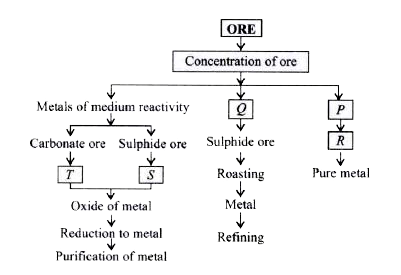Column A Column Ba. Highest element i. Cesiumb. Highest metal ii. Osmiumc. Heaviest metal iii. Lithiumd. Most reactive metal iv. Hydrogen
The correct Answer is:a.(iv), b.(iii), c.(ii), d.(i)
To solve the matching question between Column A and Column B, we will analyze each item in Column A and find the corresponding item in Column B.
1. Identify the Highest Element:
- The highest element in the periodic table is Hydrogen (H), which is located at the top of the periodic table in the first period.
- Match: a. Highest element → iv. Hydrogen
2. Identify the Highest Metal:
- The highest metal in terms of atomic number in the periodic table is Lithium (Li), which is the first metal in the periodic table, located in the second period.
- Match: b. Highest metal → iii. Lithium
3. Identify the Heaviest Metal:
- The heaviest metal based on atomic mass is Osmium (Os), which has an atomic number of 76.
- Match: c. Heaviest metal → ii. Osmium
4. Identify the Most Reactive Metal:
- The most reactive metal is Cesium (Cs), which is located in Group 1 (alkali metals) and is known for its high reactivity.
- Match: d. Most reactive metal → i. Cesium
Final Matches:
- a → iv (Hydrogen)
- b → iii (Lithium)
- c → ii (Osmium)
- d → i (Cesium)
Summary of Matches:
- a. Highest element → iv. Hydrogen
- b. Highest metal → iii. Lithium
- c. Heaviest metal → ii. Osmium
- d. Most reactive metal → i. Cesium
---
- The highest element in the periodic table is Hydrogen (H), which is located at the top of the periodic table in the first period.
- Match: a. Highest element → iv. Hydrogen
- The highest metal in terms of atomic number in the periodic table is Lithium (Li), which is the first metal in the periodic table, located in the second period.
- Match: b. Highest metal → iii. Lithium
- The heaviest metal based on atomic mass is Osmium (Os), which has an atomic number of 76.
- Match: c. Heaviest metal → ii. Osmium
- The most reactive metal is Cesium (Cs), which is located in Group 1 (alkali metals) and is known for its high reactivity.
- Match: d. Most reactive metal → i. Cesium
- a → iv (Hydrogen)
- b → iii (Lithium)
- c → ii (Osmium)
- d → i (Cesium)
- a. Highest element → iv. Hydrogen
- b. Highest metal → iii. Lithium
- c. Heaviest metal → ii. Osmium
- d. Most reactive metal → i. Cesium
Topper's Solved these Questions
- BOOK - CBSE COMPLEMENTARY MATERIALCHAPTER - CLASSIFICATION OF ELEMENTS AND PERIODICITY IN PROPERTIES EXERCISE - ASSERTION AND REASON TYPE QUESTIONS4videos
CLASSIFICATION OF ELEMENTS AND PERIODICITY IN PROPERTIES
- BOOK - CBSE COMPLEMENTARY MATERIALCHAPTER - CLASSIFICATION OF ELEMENTS AND PERIODICITY IN PROPERTIES EXERCISE - ONE WORD ANSWER TYPE QUESTIONS11videos
CLASSIFICATION OF ELEMENTS AND PERIODICITY IN PROPERTIES
- BOOK - CBSE COMPLEMENTARY MATERIALCHAPTER - CLASSIFICATION OF ELEMENTS AND PERIODICITY IN PROPERTIES EXERCISE - TRUE AND FALSE TYPE QUESTIONS10videos
CLASSIFICATION OF ELEMENTS AND PERIODICITY IN PROPERTIES
- BOOK - CBSE COMPLEMENTARY MATERIALCHAPTER - CHEMICAL THERMODYNAMICSEXERCISE - Hots Questions3videos
CHEMICAL THERMODYNAMICS
- BOOK - CBSE COMPLEMENTARY MATERIALCHAPTER - ENVIRONMENTAL CHEMISTRYEXERCISE - UNIT TEST9videos
ENVIRONMENTAL CHEMISTRY
Similar Questions
Column AColumn Ba. Fluorine i. High negative electron gain enthalpyb. Helium ii. Most electropositive elementc. Chlorine iii. Most electronegative elementd. Cesium iv. Highest ionisation enthalpy
View SolutionMatch the entries in Column A with the
appropriate ones in column B.
. Callumn A . Callumn B A. s-block ()a. Radioactive metal B. Fluorine ()b. Highest first IP value C. Chlorine ()c. Lanthanides D. d-block ()d. Highly reactive metals E. 4f-series () e. Heavy metals F Helium () f. Always from -1 oxidation G. Francium () g. Highest electron affinity H. Noble gases () h. Xero group elementsView Solution
Knowledge Check
- Question 1 - Select One
Metals are extracted from their ores by different methods depending on their position in the activity series

Match the Column-I with Column-II and select the correct option from the codes given below.
Column-I Column-II(A) Highly reactive metals(i) S (B) Calcination(ii) T (C) Electrolytic reduction(iii) P(D) Less reactive metal(iv) Q(E) Roasting(V) QA(A)-(v), (B)-(ii), (C)-(iv), (D)-(iii), (E)-(i)B(A)-(iv), (B)-(ii), (C)-(v), (D)-(iii), (E)-(i)C(A)-(iii), (B)-(ii), (C)-(iv), (D)-(v), (E)-(i)D(A)-(i), (B)-(ii), (C)-(v), (D)-(iii), (E)-(iv) - Question 2 - Select One
Match the entries of Column I with appropriate entries of Column II and chose the correct option out of the four options (a), (b), (c ) and (d) given at the end of each question.
Column IColumn II(A) Chlorine(p) Transition element(B) Helium(q) Highest electron gain enthalpy(C ) Iron(r ) Highest ionization enthalpy(D) Lithium(s) Strongest reducing agentAA-q, B-r, C-p, D-sBA-p, B-q, C-r, D-sCA-r, B-q, C-p, D-sDA-q, B-p, C-r, D-s - Question 3 - Select One
Match the column I with column II
Column IColumn II(A) Thylacine (i) Russia (B) Dodo (ii) Mauritius (c ) Quagga(iii) Australia (D) Steller's sca cow (iv) AfricaAa (ii), b (iii), c (i), d(iv)Ba(iv), b(i), c(ii), d(iii)Ca(iii), b(iv), c(ii), d(i)Da(iii), b(ii), c(iv), d(i)
Match Column I with column II
Column IColumn II(a)Bilirubin and biliverdin(i)Parotid(b)Hydrolysis of starch(ii)Bile(c)Digestion of fat(iii)Lipases(d)Salivary gland(iv)AmylasesView SolutionMatch the column I with Column II:-
Column IColumn II(A) Unicellular(i) Spirogyra(B) Colonial(ii) Kelps(C) Filamentous(iii) Volvox(D) massive plant bodies(iv) ChlamydomonasView SolutionMatch the column-
Column IColumn IIA Toxinsi. MorphineB Alkaloidsii. AbrinC Lectinsiii. VinblastinD. Drugsiv. Concanavalin A
ABCDiiiiiiiviiiiiiiviiiiviiiviiiiiiView SolutionMatch the column I and II
Column IColumn II(a) Apocarpous(i) Papaver(b) Syncarpous(ii) Michellia(c) Epiphyllous(iii) Cashew(d) Cotyledon(iv) AloeView SolutionMatch column-I with column-II and select the correct option using the given codes.
Column-I Column-IIP. A metal that forms two types of oxides(i) Cu Q. A metal used in hot water appartus(ii) Ag R. A metal which can displace hydrogen from steam only(iii) FeS. A metal that does not react with air even at high temperature(iv) ZnView Solution

